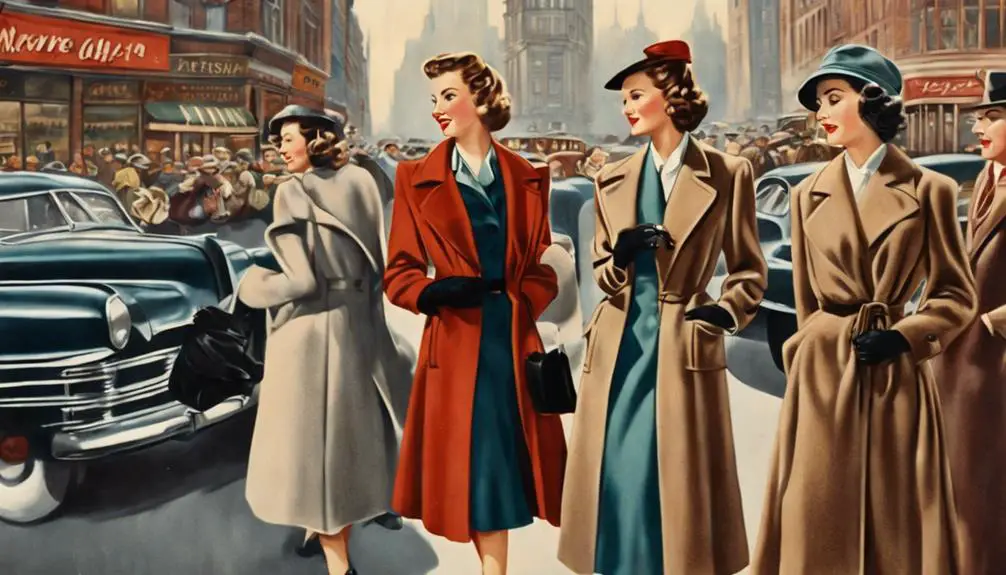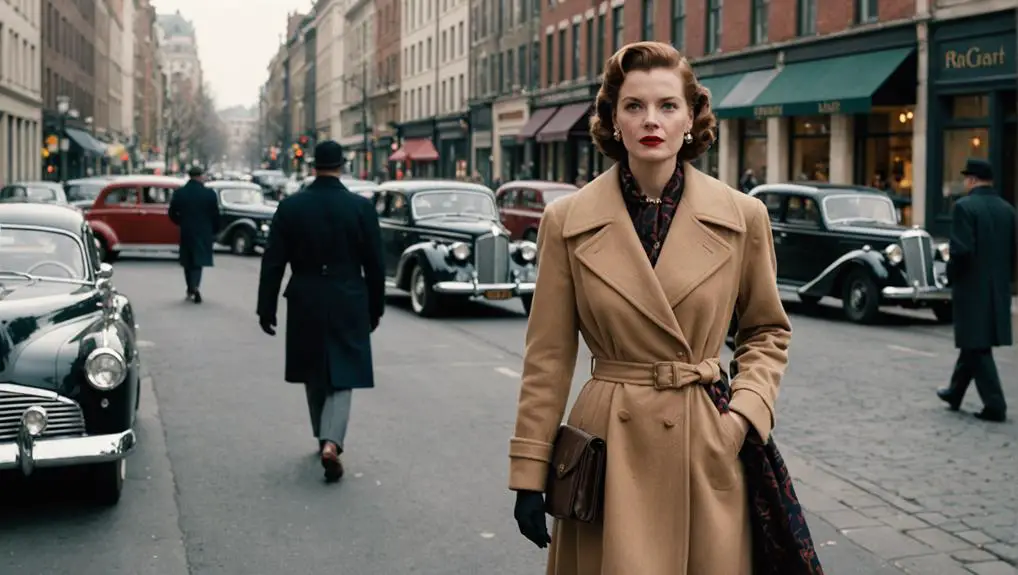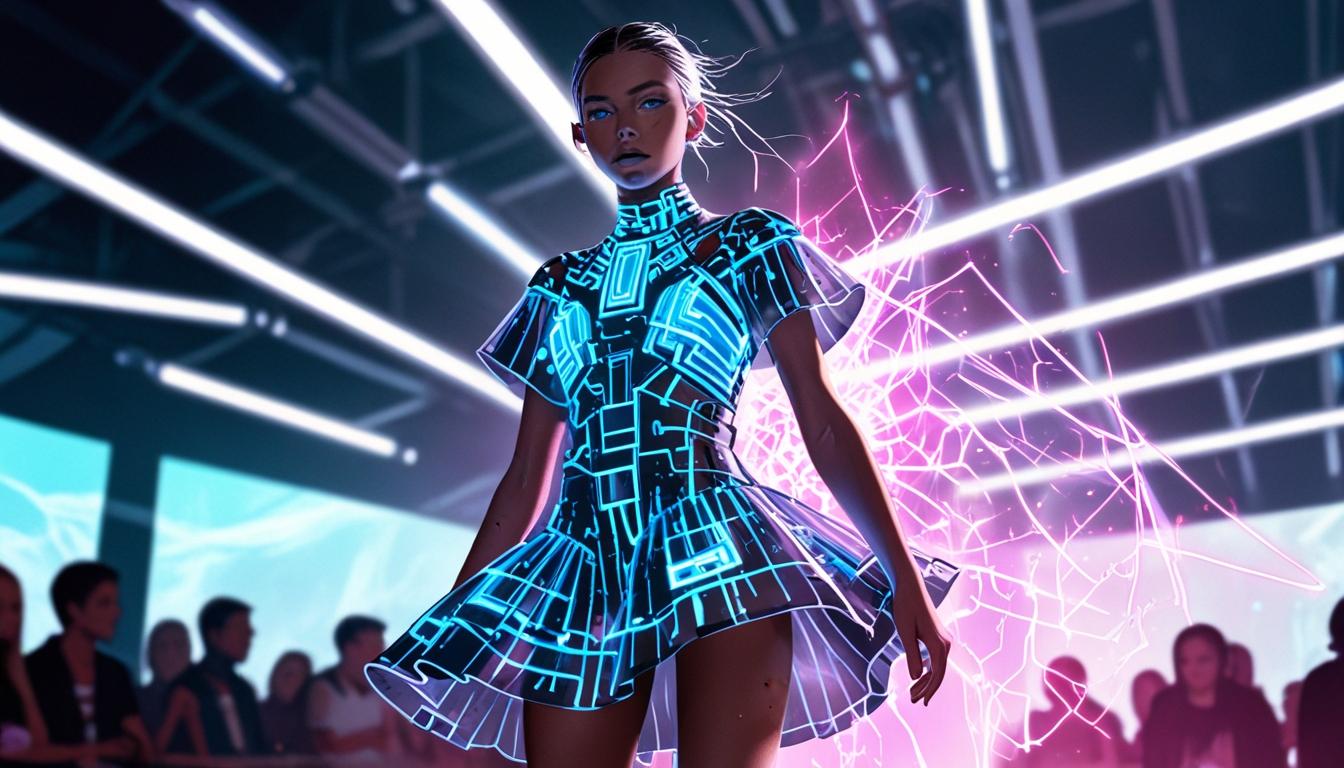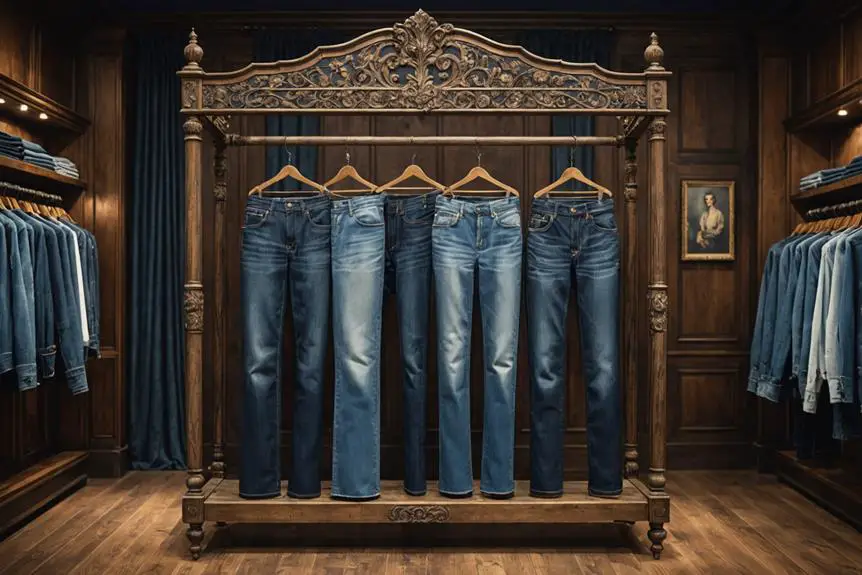Women's wrap coats in the 1940s were all about practicality and style. You'd find them made from warm wool, ideal for colder months. These coats featured wide pointed collars and tie belts, creating a flattering silhouette while ensuring functionality. The designs were influenced by military styles, showcasing large shoulder pads and long lengths. Often, muted colors like tan and navy reflected the wartime spirit. Scarcity during WWII meant many fabrics were repurposed, adding a unique aspect to these garments. If you explore further, you'll uncover more details about the distinct characteristics and historical significance of these iconic coats.
Overview of 1940s Wrap Coats

Wrap coats in the 1940s exemplified a blend of practicality and style, catering to women's needs during a tumultuous era. Designed for warmth and comfort, these coats often featured a loose fit and made from materials like wool, essential for the colder months. The influence of the L-85 regulations during World War II led to simpler coat designs, limiting features to a maximum of two pockets, which streamlined the aesthetics of wrap coats.
Characterized by wide pointed collars and a tie belt, these garments provided both functionality and a fashionable edge. The long lengths and the addition of large shoulder pads drew inspiration from military styles, emphasizing a structured silhouette that conveyed strength and resilience. Commonly available in muted tones like navy, tan, and grey, the color palette mirrored the practical, utilitarian fashion of the time.
Double-breasted variations gained popularity for their extra warmth and chic appearance, making wrap coats a staple in women's outerwear throughout the decade. Overall, the 1940s wrap coat not only offered protection against the elements but also allowed women to express their individuality amidst the constraints of wartime fashion.
Key Materials and Fabrics
Utilizing warm, durable materials was essential for the success of women's wrap coats in the 1940s, particularly during the challenging conditions of wartime. Wool emerged as the primary fabric, celebrated for its practicality and warmth. In a time of scarcity, many women repurposed wool from used coats and blankets, demonstrating resourcefulness. Rayon-wool blends were also popular, offering a balance of comfort and durability while conforming to the L-85 regulations that limited embellishments during WWII.
Wrap coats typically featured linings made from rayon crepe or satin, which enhanced wearability and comfort, vital for long days. The muted colors like tan, navy, and grey dominated this era, reflecting a focus on functionality over decoration. This choice of colors not only aligned with wartime austerity but also allowed for versatile styling.
Moreover, fabrics often underwent treatments for water resistance, making wool a favored option for colder climates. The combination of warmth, durability, and practical design elements encapsulated the essence of 1940s women's wrap coats, ensuring they remained a staple in wardrobes while addressing the harsh realities of the time.
Popular Styles and Designs

The loose fit and wide pointed collars of 1940s women's wrap coats defined an era where functionality met style. These coats, primarily made from wool, became essential outerwear, offering both warmth and elegance during a time of practical fashion. With tie belts cinching the waist, they provided a flattering silhouette that emphasized femininity amidst the "man-ish" aesthetics dominated by large shoulder pads.
The muted colors like tan, navy, and grey resonated with wartime sensibilities, allowing women to blend practicality with a touch of sophistication. The Chesterfield coat emerged as a standout design, featuring wide peak lapels and contrasting trim, capturing the essence of this iconic era.
| Style Features | Description |
|---|---|
| Fabric | Wool with rayon crepe or satin lining |
| Pockets | Typically two slit pockets |
| Length | Long, ensuring warmth and coverage |
| Shoulder Pads | Large, creating a structured silhouette |
These wrap coats not only reflected the fashion of the time but also catered to the needs of women maneuvering their roles in a changing society, making them a symbol of resilience and style.
Pricing Trends and Market Insights
Vintage women's wrap coats from the 1940s can vary considerably in price, reflecting a range of factors like material quality, condition, and rarity. Typically, you'll find a vintage 1940s wool wrap coat priced around $99.99, but the market's pricing trends show a notable spectrum. For instance, while common styles can start as low as $12.00, high-end and rare wrap coats—especially those featuring unique elements like fur collars—might command prices upwards of $299.99. The distinctive craftsmanship and unique labels associated with these garments also contribute to their value, making identifying vintage characteristics essential for collectors.
The high demand for popular styles, such as the 1940s trench wrap coat, plays an important role in influencing these prices. As autumn and winter approach, vintage outerwear becomes even more sought after, increasing its value. Additionally, you should factor in shipping costs, which can range from $8.29 to $41.68, impacting your overall investment.
Understanding these market insights can help you navigate your vintage shopping experience more effectively. As you explore options, keep an eye on the quality and rarity of the pieces, as these elements notably affect their pricing in the current market.
Tips for Vintage Shopping

Finding the perfect 1940s women's wrap coat requires a keen eye and a bit of knowledge about the era's fashion. Start by focusing on key design features like wide pointed collars and tie belts, which define these vintage coats. Authentic 1940s coats are typically crafted from wool or rayon-wool blends, reflecting the materials available during World War II. Understanding the importance of vintage clothing labels can also enhance your shopping experience; vintage tag identification provides insights into a coat's history and value.
When vintage shopping, always check for labels or tags that indicate the coat's age and authenticity; unique markings and stitching can provide valuable insights into its origin. Be mindful of size variations, as vintage sizing often differs considerably from modern standards. Many 1940s women's coats were designed to accommodate layers for warmth, so try them on with appropriate winter clothing.
Also, inspect the fabric quality closely; signs of wear, like missing buttons or fabric damage, can affect the coat's value and usability. If you find a piece that needs repairs, consider the potential repair costs before purchasing. By paying attention to these details, you can confidently navigate the vintage market and find a stunning wrap coat that embodies the charm of the 1940s.
Frequently Asked Questions
What Jackets Were Popular in the 40s?
In the 40s, you'd notice trench coats, box coats, and utility jackets dominating the fashion scene. These styles featured loose fits and practical designs, perfectly blending functionality with the era's emerging trends in women's outerwear.
What Were Fur Coats Made of in the 1940s?
Fur coats in the 1940s were crafted from various pelts like mink and fox, often repurposed due to wartime restrictions. Their designs featured high collars and utilitarian styles, emphasizing both elegance and practicality during challenging times.
How Should a Wrap Coat Fit a Woman?
A wrap coat should fit snugly at the shoulders and bust, allowing for layering. The sleeves should reach the wrists, and the waist should be cinched without bulk, creating a flattering silhouette that enhances your figure.
Did They Wear Fur Coats in the 1930s?
Yes, you'd find women wearing fur coats in the 1930s, showcasing elegance and luxury. These coats featured high collars and wide sleeves, symbolizing wealth and femininity, perfectly aligning with the glamorous fashion trends of that era.




